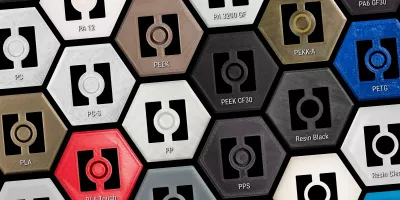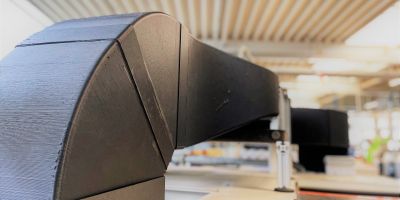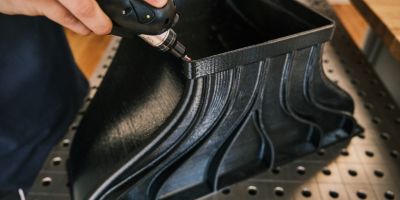3D printing with fiber-reinforced plastics
PEEK holder | FFF process
Fibre-reinforced 3D printing for high-strength components
Technical 3D printed products for industrial use require special mechanical properties and high accuracies. With fibre-reinforced materials, 3D printing enables even greater application possibilities. The polymers used are filled with carbon fibres or glass fibres, thereby improving strength, dimensional stability and surface properties. In addition to the mechanical properties, the temperature resistance is also increased.
Carbon fibre 3D printing and glass fibre reinforced 3D printing are mainly used when the printed components are used directly and are subjected to thermal and mechanical stress. Examples for the use of fibre-reinforced plastics can be found in many industries, such as mould making, tool making and fixture construction or special machine construction.
What are fibre-reinforced plastics?
Polymers are mixed with a certain percentage of mostly between 10 and 30 % carbon fibres or glass fibres and composite materials are created. Carbon fibre reinforced plastics (CFRP) and glass fibre reinforced plastics (GFRP) combine the properties of the base polymer and the reinforcing properties of the fibres. Available and interesting plastics with fibre reinforcements for technical use are, for example, PA CF (polyamide with carbon fibres), PA6 GF30 (polyamide 6 with 30 % glass fibres), PET CF (polyethylene terephthalate with carbon fibres), PC GF30 (polycarbonate with 30 % glass fibres) or also ultra performance materials such as PEEK CF30 (polyetheretherketone with 30 % carbon fibres).
Resilient printed substrate made of fibre-reinforced PETCF (PET with 15% carbon fibre content)
Materials
Here we present our available materials that are used in additive manufacturing. You will receive information on the properties and possible applications of each material.
Fibre-reinforced 3D printing and its special properties
High strength
The addition of carbon fibres increases strength between 20 and 50 % compared to unfilled plastic. Glass fibre reinforced plastics offer strength increases between 10 and 30 %. This strength increase is particularly valuable in lightweight applications, because the total weight of the printed component is only slightly increased by the additions. In some cases, the fibre-reinforced 3D printed component can also be redesigned to save material.
Low delay
With virtually all manufacturing processes in plastics processing, warpage is to be expected during processing or during production-related cooling processes. This distortion can pose a major challenge in terms of the dimensional accuracy of the final component. The addition of carbon fibres or glass fibres significantly reduces warpage, especially in additive manufacturing. This is why we often recommend carbon fibre-reinforced plastics when dimensional accuracy plays a special role and tight tolerances have to be maintained.
Heat resistance
Composite materials also have a higher heat resistance compared to non-reinforced plastic, which is up to 30 % higher. In many applications, this can save costs by not having to resort to a more cost-intensive polymer or even metal.
Stiffness
A decisive factor for fibre-reinforced printed components is the enormous increase in stiffness. This means that the component remains dimensionally stable even under load. Carbon fibre-reinforced plastics in particular score highly in terms of stiffness.
Get free advice now!
Our 3D printing professionals look forward to hearing from you. Together you will discuss the individual challenges and find economic solutions for the production of your fibre-reinforced plastic components. Arrange your non-binding initial consultation today.
Comparison: glass-fibre reinforced and carbon-fibre reinforced plastics
There are many factors to consider when deciding which fibre-reinforced plastic is best for your application.
The following table will help you decide:
How are fibre-reinforced plastics processed on the 3D printer?
The demands on additive manufacturing equipment increase with the use of GRP or CFRP materials. The processing temperatures are higher and the material behaves abrasively due to the fibre content. As a result, all components that come into contact with the material must be hardened. All of our 3D printers that are based on the fusion layer process, which is also called FDM or FFF process, are converted to process fibre-reinforced plastics at our company.
We can even produce large-format 3D printed components from fibre-reinforced materials up to 1 m³. The material PET CF is particularly suitable for this, as it is relatively inexpensive and the carbon fibre filament is available to us in large spools. Materials based on PEEK or PPS are printed on our high-temperature systems.





